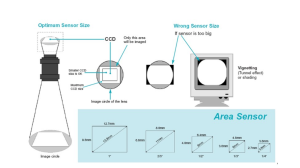Industrial lenses are very important imaging components in machine vision systems. In order for the system to fully perform its functions, industrial lenses must be able to meet the requirements. At the beginning of the 21st century, with the widespread application of machine vision systems in the field of precision detection, ordinary industrial lenses were difficult to meet the detection requirements. In order to make up for the shortcomings of ordinary lens applications and meet the needs of precision detection, telecentric lenses emerged.
Telecentric lenses, based on their unique optical characteristics such as high resolution, ultra wide depth of field, ultra-low distortion, and unique parallel light design, bring a qualitative leap to machine vision precision detection. Telecentric lenses, based on their unique optical characteristics such as high resolution, ultra wide depth of field, ultra-low distortion, and unique parallel light design, bring a qualitative leap to machine vision precision detection.

But there are still many people who are not very clear about the parameters of telephoto lenses. What does the telephoto degree of telephoto lenses mean?
Telecentricity refers to the magnification error of an object. The smaller the magnification error, the higher the telecentricity. Telecentricity has various uses, and it is important to grasp it before using the lens. The main light of the telephoto lens is parallel to the optical axis of the lens, and if the telephoto degree is not good, the use effect of the telephoto lens is not good.
It should be noted that telephoto lenses do not have a greater depth of field than regular lenses. In fact, a high telecenter does not necessarily mean a large depth of field, which only depends on F-number and resolution. When using a telephoto lens, the image will also blur as the object moves away from the optimal focal length, but it is symmetric blur (which has been recognized as an advantage of telephoto lenses).
As long as the features of the object are within the working distance of the telecentric lens, the magnification of the image remains constant, in other words, the features close to the lens are not larger than the images far away. For example, it is necessary to simultaneously detect the thread distribution of two identical screws spaced 10mm apart. For example, it is necessary to simultaneously detect the thread distribution of two identical screws spaced 10mm apart.
Telecentric lenses are mainly used for precision measurement. In precision optical measurement systems, there are certain limiting factors due to ordinary optical lenses, such as image deformation, errors caused by angle selection, and boundary uncertainty caused by improper light source interference, which can affect the accuracy of measurement. The telecentric lens can effectively reduce or even eliminate the aforementioned problems, and has become a decisive component of precision optical measurement systems, with its application fields becoming increasingly widespread.



